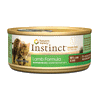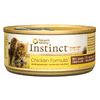Rotation feeding is a holistic nutritional philosophy for nourishing your pet’s health and happiness. It means varying both proteins (chicken, beef, lamb, etc.) and forms (raw, cans, dry, etc.) fed to your pet. In essence, the simplest way to think of rotation feeding is to think about your own diet. Do you eat the same meal every morning and every night? No, of course you don’t. Humans have the ability to choose different foods every day. Chances are, if you ate chicken and rice every morning and every night for your meal, you would become bored and experience nutritional deficiencies. Similarly, if you ate soup for every meal, you may get tired of the texture. Rotation feeding allows pets to enjoy a variety in their diet, and enables them to experience different flavors and textures for health and happiness.
There are many health and behavioral benefits to rotation feeding. It is best that rotation feeding is started at a young age, but pets of all ages can be fed a variety of proteins and food forms. The four major benefits to rotation feeding are:
1. Reduced risk of food allergies and intolerances. Most food-related allergies and intolerances develop against common ingredients such as chicken, beef, wheat, corn, or soy. These health issues typically develop over time because many pet owners consistently feed the same food flavor and form – they do not rotate. Internally, your pet’s body experiences a reaction to the proteins found in the food ingredients they have been eating day after day. If it is an allergy, there is a true immune response that may manifest as itchy skin, hot spots, foot biting, or other behaviors. Intolerances usually do not cause an immune reaction but may appear as digestive upset or colitis. Rotation feeding mitigates the risk that the body develops these reactions because a specific protein source is not fed long enough for the body to become sensitive towards it. Always look for food free of corn, wheat, and soy, and be sure to rotate between animal protein sources.
2. Interest in the food dish (reduced pickiness). When pets become accustomed to certain textures, flavors, and even brands; they become less inclined to try new foods. With a variety of food choices, your pet can remain excited about the foods in his or her dish and stay interested in the food dish at each and every meal. The variety you provide to your pet (in addition to obedience training) may also help reduce the incidence of destructive behaviors, which may have developed out of boredom.
3. More complete micro-nutrient intake (rotation of proteins). Most premium natural pet foods, are complete and balanced. However, every food ingredient has a unique nutritional profile. This includes amino acid ratios, fatty acid profiles, and micro or trace nutrient compositions. For example, oatmeal is a great source of lutein, while brown rice is rich in manganese. Variety in your pet’s diet delivers different food ingredients and promotes a well-balanced nutrient intake from a wide array of foods. Feeding Instinct Duck Meal and Turkey Meal Formula, which includes carrots, supplies your pet with the amino acid tryptophan and several carotenoids for eye health. Feeding Prairie Salmon Meal and Brown Rice Medley, which includes cranberries, provides omega fatty acids and antioxidants for immune health. Both are excellent and complete diets that can be fed without rotating, but rotation allows your pet to experience the benefits of both.
4. Increased water consumption (rotation of forms). All pets need water. However, not all pets will drink water. The ancestors of our pets drank very little water because they ate fresh prey, which is over 70% moisture. Water is critical to life. Without adequate water intake, our cells experience detrimental effects and begin to die. Many health problems that veterinarians see in their clinics are related to water imbalance. Urinary tract disease (stones, crystals), liver disease, kidney disease, and constipation are all indirectly related to water balance. Typically, the symptoms of these diseases can be alleviated by feeding a high moisture diet such as canned or raw frozen. Once the body is properly hydrated, the liver, kidney, and bowels have the opportunity to function correctly. More importantly, the urine becomes more dilute which prevents crystals from forming or turning into stones. The first line of defense against urinary tract disease is not always feeding a special diet – generally veterinarians will first suggest that their clients increase the pet’s water consumption.
Pets of all breeds and all ages benefit from rotation feeding Ideally, rotation feeding should start as soon as your puppy or kitten can eat solid food. Starting with various flavors of canned and kibble mixed occasionally with raw frozen diets is an easy way to introduce your new family member to the benefits of a natural, variety-based diet. Eventually, the amount of raw diet you feed your pet can be increased so that your pet is eating all 3 forms. These three forms need not be fed at the same meal – some people mix kibble and raw or kibble and canned while others feed kibble for breakfast and canned or raw for dinner. Any of these combinations are acceptable – the idea is simply to offer a variety.
If your pet is older, introducing him/her to rotation feeding may take a little bit of patience. For example, it is much easier to transition younger animals to raw diets than it is for older animals. For these cases, some owners find it useful to gently cook the raw food and serve it with canned or kibble, gradually decreasing the cooking time until the raw food is not cooked at all. It is often recommended that small amounts of kibble be blended into the canned food to accustom your pet to the new texture of a dry food. Alternatively, some owners pour a natural chicken broth over the kibble.
Each pet is unique and there may still be some flavors he/she does not like. Interestingly, when disliked flavors are re-introduced after a few months of rotation feeding, many pets readily accept the once disliked flavor. Or perhaps your pet has already developed allergies to certain ingredients. In these cases, any degree of food rotation will be beneficial. Food allergies or intolerance are slightly different and may require a stricter diet until the reaction subsides. However, once the food-related problem is under control and the pet is being fed a variety of flavors and forms, many owners report that their pet is able to tolerate small amounts of the once problematic ingredient. Raw frozen diets are excellent for pets with food related allergies.








